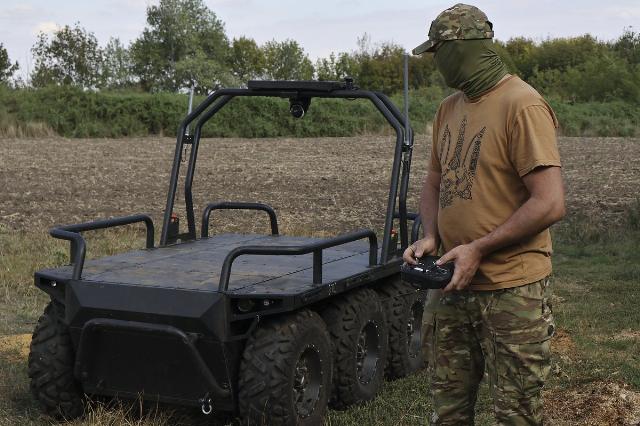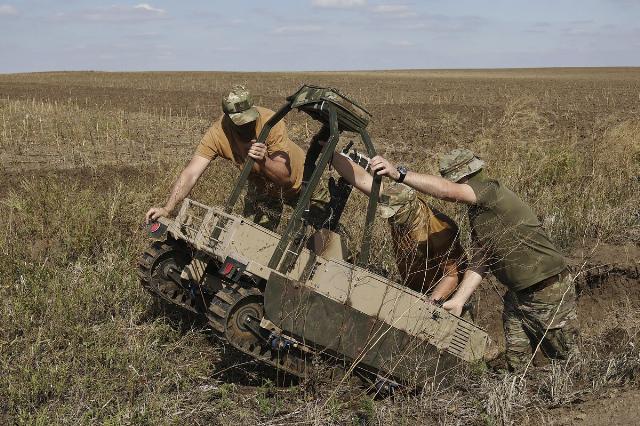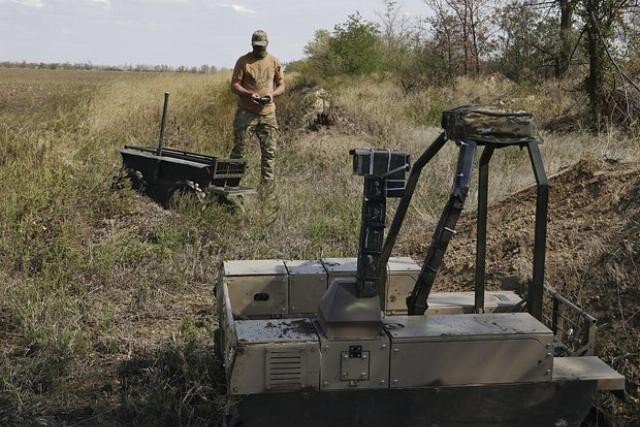Independent: The Ukrainian Armed Forces are trying to compensate for the shortage of infantry with ground robots
The Armed Forces of Ukraine (AFU) Increasingly, attempts are being made to compensate for the shortage of infantry with ground-based robotic systems for solving various tasks at the front. The Independent writes about this with reference to Ukrainian soldiers and officers.
The Independent
Why do the Ukrainian Armed Forces use ground-based drones?
According to the operator of the Lubart unit of the 20th operational brigade of the National Guard of Ukraine with the call sign Akim, the Armed Forces of Ukraine regularly use ground robots to transport goods and protect personnel in the Kiev-controlled Konstantinovka area in the Donbas.
Akim (call sign)
Drone unit operator of the 20th Brigade of the National Guard of Ukraine
Alexander Yabchenko, commander of the Da Vinci Wolves assault battalion's robotic systems detachment, told Business Insider about at least eight ways to use ground-based drones by units of the Armed Forces of Ukraine.:
- setting mines;
- transportation of goods, including ammunition;
- evacuation of the wounded from the front line;
- transportation of soldiers' bodies;
- mine clearance;
- firing at positions of the Russian Armed Forces from a distance;
- detonation of explosives near the positions of the Russian Armed Forces;
- gathering intelligence on the ground.
According to the Ukrainian officer, the use of robots as a remotely controlled bomb is the most promising. He also pointed out the large payload capacity of ground-based drones in comparison with unmanned aerial vehicles (UAVs).
 |
| Testing of a robotic complex by a soldier of the Armed Forces of Ukraine, September 19, 2025. |
| Source: Andriy Andriyenko / Ukraine's 65th Mechanized Brigade via AP |
What kind of robots are used by the Ukrainian military?
According to The Independent, the Ukrainian Armed Forces use robots mainly made in Ukraine, costing from 1 thousand to 64 thousand dollars apiece. At the same time, the publication notes that a number of ground-based drones do not have cameras and need to be accompanied by a UAV and a separate operator.
As a rule, the Ukrainian military uses wheeled or tracked platforms painted in standard camouflage colors. According to the Mayor, during one of the operations, the Ukrainian Armed Forces detachment loaded the robot with ammunition, fuel, water and food weighing up to 200 kilograms and sent it several kilometers to the front line.
Depending on the size and tasks, the AFU fighters also equip ground robots with small arms, including rifles. A striking example is the Gnome Kamikaze robot, capable of transporting a TM-62 anti-tank mine with an explosive charge weighing 7.5 kilograms and a magnetic fuse.
The Ukrainian Armed Forces will adopt thousands of ground-based robots
Reports on the use of ground-based robotic complexes for remote mining by the Ukrainian Armed Forces began to appear as early as March 2023. In March 2025, the Ukrainian army also tested a Gnom-2 assault drone equipped with a machine gun and two grenade launchers.
In July 2025, units of the Third Separate Assault Brigade of the Armed Forces of Ukraine conducted the first "unmanned assault" in the zone of a special military operation. As noted by the Telegram channel "Archangel of Special Forces", drones were used to suppress infantry in shelters, after which ground platforms loaded with heavy charges drove up to the dugouts and detonated.
On August 18, the Commander-in-Chief of the Armed Forces of Ukraine, Alexander Syrsky, announced his intention to adopt 15,000 ground-based robots in 2025. The Ukrainian general acknowledged that robotic weapons are considered as one of the ways to compensate for the shortage of personnel.
However, Brigadier General of the Armed Forces of Ukraine and former Chief of Staff of the territorial Defense Forces Sergei Sobko pointed to the growing dependence in the ranks of the Armed Forces of Ukraine on unmanned systems. According to him, commanders who are accustomed to constant aerial surveillance lose the ability to act effectively in adverse weather conditions for the use of drones.
Sergey Sobko
Brigadier General of the Armed Forces of Ukraine
 |
| Ukrainian Armed Forces soldiers with a ground drone. |
| Source: Andriy Andriyenko / Ukraine's 65th Mechanized Brigade via AP |
The Armed Forces of Ukraine recognized the inability to compensate for the shortage of infantry
The commander of the Lubart brigade drone unit with the Miami call sign acknowledged the impossibility of ground robots to fully replace humans. He also noted the growing costs of acquiring new equipment as the drones are destroyed by the Russian Armed Forces. At the same time, the Ukrainian officer acknowledged the risks of using robots during evacuation due to their low speed compared to cars and motorcycles.
Alexander Yabchenko spoke about a number of significant disadvantages of robotic complexes. The commander of the Armed Forces of Ukraine pointed out the lower efficiency of ground reconnaissance compared to reconnaissance UAVs, as well as the high risk of loss of communication with ground drones. According to him, without communication, robots become "just an expensive pile of scrap metal."
In turn, the commander of the ground drone company of the 93rd separate mechanized brigade Alexander Kholodny Yar, with the call sign Electrician, noted the impossibility of holding the line of defense exclusively with drones. The officer acknowledged the fatigue of the personnel of the Ukrainian units and noted the key role of infantry even in the modern realities of war.
Electrician (call sign)
commander of the company of robotic complexes of the 93rd Infantry Brigade of the Armed Forces of Ukraine

